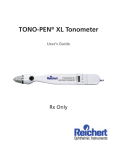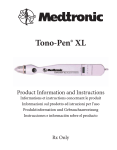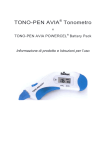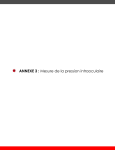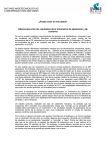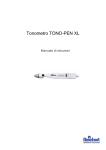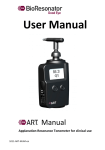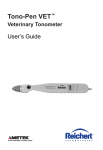Download Reichert TONO-PEN VET User`s guide
Transcript
TONO-PEN VET™ Tonometer User’s Guide Rx Only Table of Contents Introduction ..................................... 4 Warnings and Cautions................ 6 Setup.................. 8 Calibration...................... 11 Taking a Measurement...................... 13 Interpreting the LCD........................ 16 Maintenance & Storage........................ 17 Troubleshooting........................ 19 Guidance and manufacturer’s declaration........... 20 Warranty........................ 23 Page Introduction Overview The Reichert TONO-PEN VET is a precision electronic tonometer which measures intraocular pressure (IOP). The body of the instrument is specially designed to fit comfortably in the user’s hand, facilitating fast and accurate measurements. The stainless steel probe on the TONO-PEN VET contains a solid state strain gauge which converts intraocular pressure (IOP) to an electrical signal. The probe tip must be covered by a protective membrane. Reichert OCU-FILM® Tip Covers are recommended. Utilizing a sophisticated “single chip” microprocessor and electronics housed in the body of the instrument, the waveform produced by each touch to the anesthetized corneal surface is analyzed and stored for a statistical comparison process. Each single valid IOP reading is digitally displayed on the liquid crystal display (LCD). When four valid readings are obtained, the mean IOP and the standard deviation for those readings (an indication of reliability) are shown on the LCD. Intended Use The TONO-PEN VET is intended for measuring IOP as a screening/monitoring tool for Glaucoma or when increased IOP is suspected. Components The TONO-PEN VET unit (see Figure 1) is provided in a storage case, complete with: • • • • • Page Ocu-Cel™ XL Batteries OCU-FILM® Tip Covers Stylus Blade for battery replacement Desiccant to keep the instrument and components dry (not shown in Figure 1) Instruction Manual Introduction Instruction Manual OCU-FILM Tip Covers TONO-PEN VET Tonometer Ocu-Cel XL Batteries Stylus Blade Figure 1 TONO-PEN VET Components (in Storage Case) Page Warnings and Cautions WARNING: AN INSTRUCTION THAT DRAWS ATTENTION TO RISK OF INJURY OR DEATH WARNING: THE TONO-PEN VET SHOULD BE USED IN STRICT ACCORDANCE WITH THE INSTRUCTIONS OUTLINED IN THIS USER’S GUIDE. THE SAFETY OF THE PATIENT AND THE PERFORMANCE OF THE INSTRUMENT CAN NOT BE GUARANTEED IF USED IN A MANNER NOT SPECIFIED BY REICHERT, INC. WARNING: THE BATTERY SHOULD ONLY BE REPLACED WITH THE BATTERY SPECIFIED IN THIS MANUAL (OCU-CEL™ XL Battery). USE OF ANOTHER BATTERY MAY CAUSE FIRE OR AN EXPLOSION. WARNING: DO NOT PLACE A SHORTING DEVICE BETWEEN THE BATTERY TERMINALS, OR ALLOW THE BATTERY TO BECOME WET. DO NOT DISASSEMBLE OR DISPOSE OF THE BATTERY IN A FIRE. MISUSE OR IMPROPER DISPOSAL OF THIS BATTERY MAY CAUSE IT TO BECOME VERY HOT, IGNITE OR EXPLODE. DAMAGE TO THIS UNIT AND/OR SERIOUS PERSONAL INJURY MAY RESULT. WARNING: DO NOT EXPOSE THE BATTERIES TO TEMPERATURES ABOVE 140º F. DO NOT DISASSEMBLE THE BATTERIES. DO NOT CARRY BATTERIES LOOSE IN A POCKET OR ELSEWHERE. DAMAGE TO THIS UNIT AND/OR SERIOUS PERSONAL INJURY MAY RESULT. WARNING: IN ORDER TO ENSURE THAT CORRECT OPERATION OF THE INSTRUMENT IS MAINTAINED, AND TO GUARANTEE THE SAFETY AND RELIABILITY OF THE INSTRUMENT, ANY REPAIR OR SERVICE MUST BE PERFORMED BY REICHERT, INC. OR AN AUTHORIZED SERVICE AGENT OF REICHERT, INC. WARNING: APPROPRIATE CLINICAL PERSONNEL ONLY SHOULD USE THIS DEVICE IN ORDER TO AVOID THE RISK OF DAMAGING A PATIENT’S EYE. BE SURE NOT TO APPLY TOO MUCH FORCE TO THE PROBE TIP AS THIS MAY CAUSE EYE INJURY. A QUICK, GENTLE TAPPING TECHNIQUE IS SUFFICIENT TO ACHIEVE MEASUREMENTS. WARNING: OCU-FILM CONTAINS NATURAL RUBBER LATEX WHICH MAY CAUSE ALLERGIC REACTIONS. QUESTION PATIENTS ABOUT ALLERGIES TO LATEX BEFORE EXAMINING THEM WITH THE TONO-PEN VET. WARNING: DO NOT RECHARGE THE BATTERIES. THE BATTERY IS NOT DESIGNED TO BE CHARGED BY ANY OTHER ELECTRICAL SOURCE. CHARGING COULD GENERATE GAS AND INTERNAL SHORT-CIRCUITING, LEADING TO DISTORTION, LEAKAGE, OVERHEATING, EXPLOSION OR FIRE. WARNING: NEVER SWALLOW. ALWAYS KEEP THE BATTERY OUT OF REACH OF INFANTS AND YOUNG CHILDREN TO PREVENT IT FROM BEING SWALLOWED. IF SWALLOWED, CONSULT A PHYSICIAN IMMEDIATELY. WARNING: IF LEAKAGE IS SUSPECTED OR YOU DETECT A STRONG ODOR, KEEP THE BATTERY AWAY FROM FIRE, BECAUSE THE LEAKED LIQUID COULD CATCH ON FIRE. Page Warnings and Cautions WARNING: NEVER ALLOW LIQUID LEAKING FROM THE BATTERY TO GET IN YOUR EYES OR MOUTH. BECAUSE THIS LIQUID COULD CAUSE SERIOUS PERSONAL INJURY, IF IT DOES COME IN CONTACT WITH YOUR EYES, FLUSH THEM IMMEDIATELY WITH PLENTY OF WATER AND CONSULT A PHYSICIAN. LIKEWISE, IF THE LIQUID GETS IN YOUR MOUTH, RINSE IMMEDIATELY WITH PLENTY OF WATER AND CONSULT A PHYSICIAN. CAUTION: AN INSTRUCTION THAT DRAWS ATTENTION TO THE RISK OF DAMAGE TO THE PRODUCT. CAUTION: DO NOT USE ANY SOLVENTS OR STRONG CLEANING SOLUTIONS ON ANY PART OF THIS INSTRUMENT OR DAMAGE TO THE UNIT MAY OCCUR. CAUTION: THE TIP OF THE TONO-PEN VET IS A SENSITIVE ELECTRONIC COMPONENT. BE CAREFUL NOT TO BUMP OR JAR THE UNIT AS THIS MAY DAMAGE THE TIP AND EFFECT OPERATION. CAUTION: DO NOT IMMERSE PROBE IN FLUIDS. THIS WILL CAUSE DAMAGE TO THE ELECTRONICS AND VOID THE WARRANTY. CAUTION: DO NOT STERILIZE THE PROBE. THIS WILL CAUSE DAMAGE TO THE ELECTRONICS AND VOID THE WARRANTY. CAUTION: Check to be sure that the batteries are installed correctly. Incorrect installation could cause severe damage to the electronics and void the Warranty. CAUTION: USE OR STORAGE OF THE TONO-PEN VET UNIT WITHOUT AN OCU-FILM TIP COVER CAN CAUSE SEVERE DAMAGE TO THE INSTRUMENT AND VOID THE WARRANTY. CAUTION: REMOVAL OF THE ATTACHMENT SCREW WILL VOID THE WARRANTY. CAUTION: MEDICAL ELECTRICAL EQUIPMENT NEEDS SPECIAL PRECAUTIONS REGARDING EMC AND NEEDS TO BE INSTALLED AND PUT INTO SERVICE ACCORDING TO THE EMC INFORMATION PROVIDED IN THIS GUIDE. CAUTION: ELECTROMAGNETIC INTERFERENCE FROM OTHER DEVICES MAY AFFECT THIS INSTRUMENT. IF INTERFERENCE IS PRESENT, TURN OFF OTHER ELECTRONIC DEVICES, OR REMOVE THEM FROM THE IMMEDIATE AREA WHILE OPERATING THIS INSTRUMENT. CAUTION: PORTABLE AND MOBILE RF COMMUNICATIONS EQUIPMENT CAN AFFECT MEDICAL ELECTRICAL EQUIPMENT. CAUTION: THE TONO-PEN VET SHOULD NOT BE USED ADJACENT TO OR STACKED WITH OTHER EQUIPMENT. IF ADJACENT OR STACKED USE IS NECESSARY, THE TONO-PEN VET SHOULD BE OBSERVED TO VERIFY NORMAL OPERATION IN THE CONFIGURATION IN WHICH IT WILL BE USED. Page Setup Set Up Instructions To set up the TONO-PEN VET for operation, follow the instructions listed below: 1. . 3. 4. 5. 6. . 8. 9. Remove all protective packaging materials. Remove and discard the desiccant. Carefully remove the tonometer and accessories from the case. Check for missing items. Visually check the instrument and accessories for damage. Remove the Ocu-Film Tip Cover shipped with the TONO-PEN. Notify Reichert Customer Service immediately if any components are missing or damaged. Install the batteries in the battery compartment (see page 9). Perform the Calibration Procedure (see page 11). Slide a new Ocu-Film Tip Cover over the TONO-PEN VET unit’s stainless steel probe until the Ocu-Film ridge is seated in the groove (see Figure 2). The Ocu-Film Tip Cover should fit over the probe tip (see Figure 3), without being too tight. Proper fit makes contact with the transducer surface (probe post), but still has pleats along the side of the transducer head assembly. Probe Post Groove Probe Tip Operator’s Button LCD Battery Compartment Figure 2 TONO-PEN VET Top and Side Views Page Setup Ocu-Film Tip Cover - Correct Ocu-Film Tip Cover - Too Loose Ocu-Film Tip Cover - Too Tight Figure 3 Ocu-Film Tip Cover Placement Battery Installation The TONO-PEN VET is supplied with four Ocu-Cel™ XL 3.0 volt lithium manganese dioxide batteries that need to be installed in the TONO-PEN VET. It is recommended that Reichert Ocu-Cel XL Batteries be used when the batteries need replacement. Note: The TONO-PEN VET unit will not function properly with mercury batteries. Installation Procedure 1. . 3. 4. Locate the battery compartment (see Figure 4). Open the battery compartment by gently inserting the stylus blade (see Figure 4) in the end slot. After insertion, slowly push the stylus forward and pry the cover up to remove. Using the other end of the stylus, insert the tip into the holes on the underside of the body mold. Insert the tip perpendicular into the battery removal holes on the bottom of the base housing to push the batteries out (see Figure 4). Insert two batteries as shown in Figure 4 (also diagrammed on the floor of the battery compartment). Replace the battery cover. CAUTION Check to be sure that the batteries are installed correctly. Incorrect installation could cause severe damage to the electronics and void the Warranty. Page Setup - + + - Figure 4 Replacing Batteries Page 10 Calibration Calibration Procedure The TONO-PEN VET unit is internally calibrated, thus the instrument calibration should be checked only before the first use each day or in the event of unanticipated readings. Calibration must be routinely and successfully performed once daily prior to instrument use. Calibration should also be performed whenever it is indicated by the LCD display, when batteries are replaced, or after an unsuccessful calibration. It is not necessary to check calibration prior to each use: 1. . 3. 4. 5. 6. . Point the transducer end of the TONO-PEN straight down towards the floor (see Figure 5a). Depress the Operator’s Button two times rapidly. The time between the first and second button press must be between 0.5 and 1.5 seconds. The TONOPEN will “beep” and display CAL. Wait approximately 15 seconds for the TONO-PEN to “beep”. The display will change from CAL to UP. Immediately (within 1 second) invert the TONO-PEN smoothly, pointing the transducer end straight up (see Figure 5b). A properly functioning TONO-PEN will display Good followed by a “beep”. Repeat this Calibration Procedure if bAd is displayed. After Good is displayed, depress the Operator’s Button one time and the TONO-PEN will display [8.8.8.8], followed by a single row of dashes, [- - - -], and then by a double row of dashes [====] followed by a “beep” tone, indicating the instrument is ready to measure IOP (Depressing the activation button a second time will interrupt this process and send the unit into calibration mode). Figure 5a Figure 5b Page 11 Calibration Unsuccessful Calibration If several consecutive attempts at checking the calibration are unsuccessful: Loosen or remove the Ocu-Film Tip Cover from the TONO-PEN VET probe tip and repeat the calibration check. If still unsuccessful: Spray the probe tip with compressed gas, and repeat the calibration check. If still unsuccessful: Replace the batteries and repeat the calibration check. Note: If “CAL” appears followed by a row of four dashes [- - - -], the unit did not go into calibration mode. To correct this, depress the button quicker two times or slower two times (see step 2 of calibration procedure). Note: Do not take measurements with the instrument if two consecutive “good” calibration checks cannot be obtained. The instrument will not take a measurement when the prior calibration check was “bAd”. Note: If the TONO-PEN VET fails to yield a “Good” calibration, call Reichert Technical Service. Page 12 Taking a Measurement Instrument Preparation Prior to using the TONO-PEN VET for IOP measurement prepare the instrument according to the instructions below: 1. Allow the instrument to thermally stabilize at room temperature (72-82° F, 22 - 28° C) for approximately 30 minutes prior to use. . Remove the Ocu-Film Tip Cover from the probe. Visually inspect the tonometer’s probe tip for cracks, chips or other irregularities. If irregularities are present, contact Reichert. Do not use the instrument. 3. If the probe tip passes a visual inspection, proceed. 4. To help prevent build-up of debris around the probe post, spray the probe tip with compressed gas before the first use of the day. 5. Cover the TONO-PEN VET probe tip with a new Ocu-Film Tip Cover. Reichert Ocu-Film Tip Covers are: • Individually wrapped and non-sterile sanitized • For Single Use only 6. Perform daily routine calibration (See page 11) Note: Calibration should only be performed on the TONO-PEN once daily, unless otherwise indicated by the instrument. The TONO-PEN does not require calibration after every patient examination. CAUTION Do not use the instrument without an Ocu-Film Tip Cover. Use without an Ocu-Film Tip Cover will damage the instrument and void the Warranty. Performing IOP Measurements After the TONO-PEN VET has been prepared for operation, the patient must be prepared and then IOP measurements can be performed. CAUTION Ocu-Film contains natural rubber LATEX which may cause allergic reactions. Question patients about allergies to Latex before examining them with the TONOPEN VET. To prepare a patient for an IOP measurement: Instill a drop of topical anesthetic onto the eye to be examined. 1. Position the patient, seated or supine, in front of a fixation target; or have the . patient fixate on a point of reference (i.e. ear, nose, distant object) to minimize eye movement. Note: The TONO-PEN VET unit will function in any stable position. Page 13 Taking a Measurement To perform an IOP measurement: 1. Instruct the patient to look straight ahead at the fixation target with his/her eyes fully open. . Hold the TONO-PEN VET unit as you would a pencil. 3. Position yourself to facilitate viewing of the probe tip and patient’s cornea where contact will be made. For normal corneas, central corneal contact is recommended. 4. Brace the heel of your hand on the patient’s cheek for stability while holding the TONO-PEN VET unit perpendicular to and within 1/2 inch of the patient’s cornea. (See Figure 6 for correct positioning.) Correct Incorrect Figure 6 Corneal Applanation 5. 6. . 8. 9. Page 14 To initiate an IOP measurement, depress the Operator’s Button once, and only once. Initially you will see a brief display of [8.8.8.8]. This is a self-test of the LCD (Liquid Crystal Display). If any of the LCD segments are not displayed, the TONO-PEN requires service. If a momentary display of [CAL] is seen, followed immediately by a single row of dashes [- - - -], it indicates that the TONO-PEN requires calibration before it will measure. If a double row of dashes [====] is seen and a “beep” tone is heard, it indicates that the TONO-PEN is ready to measure IOP. Proceed with applanation within 15 seconds. Note: After acquiring the double row of dashes [====], if more than 15 seconds elapses prior to applanation, the TONO-PEN will not measure. The software will have initiated a battery-saving function, indicated initially by the display of a single row of dashes [- - - -], then followed in sequence by a blank display [ ]. A new IOP measurement can be initiated by depressing the operator’s button once. Taking a Measurement Note: Anytime the operator’s button is depressed twice within 1.5 seconds, (which may be caused by operator’s inadvertent pressure on the button) the software will interpret this as a demand for calibration. Then a sustained display of [CAL] will be seen which initiates the calibration sequence. The calibration sequence must be successfully completed before further measurements can be accomplished. 10. 11. 1. Once activated, after [====] is displayed and a “beep” tone is heard, touch the TONO-PEN VET unit to the cornea lightly and briefly, then withdraw. Repeat several times. The corneal surface needs only to be momentarily contacted; indentation is not required and may lead to inaccurate readings. A chirp will sound and a digital IOP measurement will be displayed each time a valid reading is obtained. The single horizontal bar at the bottom of the LCD, indicating statistical reliability, will not be displayed with each single IOP measurement. After four (4) valid readings are obtained, a final beep will sound and the averaged measurement will appear on the LCD along with the single bar denoting statistical reliability. Note: If a single row of dashes [- - - -] appears on the LCD after the final beep, an insufficient number of valid readings was collected. If this occurs, repeat the patient examination procedure, starting at step 1. 13. To take another measurement, reactivate the TONO-PEN VET unit by pressing and releasing the activation switch as described in step 5. Note: If not reactivated within 25 seconds, the TONO-PEN VET unit will automatically turn off and the LCD will clear, placing the device in sleep mode, to conserve battery life. If this occurs, activate the TONO-PEN VET by pressing the Operator’s Button once. 14. 15. Replace the Ocu-Film Tip Cover before using the TONO-PEN VET unit on another patient and before storage. Note: Failure to replace the Ocu-Film Tip Cover between patients may result in unreliable readings of IOP by allowing debris to enter the transducer assembly. Note: A reused Ocu-Film Tip Cover may leak. This may cause damage to the strain gauge and void the Warranty. Page 15 Interpreting the LCD The number display represents IOP in millimeters of mercury (mmHg.) A number with a single horizontal bar displayed at the bottom of the LCD is an average of the valid measurements. A number without the single bar is a single measurement of IOP. (See Figure 7). The display of one of four horizontal bars located along the lower border of the LCD block indicates the statistical reliability of the averaged measurement. For example, if the 5% bar is displayed, the standard deviation of the valid measurements is 5% or less of the number shown. If the reliability measure is 20% or > 20%, a repeat measurement is recommended. A single row of dashes [- - - -] indicates that the instrument is activated. Two rows of dashes [====] followed by a “beep” indicates that the instrument is ready to take measurements. “CAL” indicates that the instrument is in the process of calibration check or the instrument needs to undergo calibration check procedure. If “CAL” is displayed following a long beep and “- - - -”, the latter is the case. A “Good” calibration check must be obtained. Figure 7 LCD (Single Measurement) “Lob” indicates the need to replace both batteries prior to using the instrument. “UP” indicates that the instrument is being calibrated and the probe tip should be turned from pointing down to pointing up. “Good” indicates the calibration check procedure was successful. After two “Good” calibration checks, the TONO-PEN VET unit is ready for use in patient examinations. “bAd” indicates the calibration check procedure was unsuccessful and must be repeated. Page 16 Maintenance & Storage Instrument Storage 1. . 3. Cover the probe tip with an Ocu-Film Tip Cover for protection. If the TONO-PEN VET unit is not to be used until a subsequent day, the instrument and accessories should be replaced in the storage case provided. If the TONO-PEN VET unit is not to be used for an extended period of time, remove the batteries from the instrument. Maintenance Procedures Maintenance that should be performed on the TONO-PEN VET consists of activities such as protecting the probe tip, keeping surfaces free of dust and dirt and storing in a dry and cool place so as not to adversely affect electronic parts, and replacing the batteries. Keep the probe tip protected with an Ocu-Film Tip Cover when in use or in storage. Avoid any contact with the probe tip when not protected by an Ocu-Film Tip Cover. The probe post must be cleaned only with optical quality compressed gas before the first use each day, before instrument storage, in the event of unanticipated readings or if a “Good” calibration check cannot be obtained. To clean the probe post: 1. . 3. 4. Remove the Ocu-Film Tip Cover. Spray the compressed gas onto the probe tip for approximately 2 seconds. Wait 3 minutes to allow the instrument to thermally stabilize. Cover the TONO-PEN VET unit’s probe tip with a new Ocu-Film Tip Cover. TONO-PEN VET Body Avoid any shock or excessive vibration which will damage the unit. Clean with a nonabrasive, dry cloth. CAUTION DO NOT IMMERSE TONO-PEN VET BODY IN FLUIDS. THIS WILL CAUSE DAMAGE TO THE ELECTRONICS AND VOID THE WARRANTY. Battery Replacement The batteries need replacing when multiple beeps sound and “Lob” appears on the LCD upon depressing the activation switch. Occasionally, a noticeable slowing in the calibration check process or in activating the instrument for taking measurements may suggest that the batteries need replacing. Always replace both batteries. Do not mix used and new batteries in the instrument. Reichert OCU-CEL XL batteries are recommended. Note: The instrument will not function properly when mercury batteries are used. Page 17 Maintenance & Storage Replace the batteries using the procedure described on page 9. If the instrument is not to be operated for an extended period of time, remove both batteries. This will avoid possible damage to the instrument due to battery leakage Attachment Screw The attachment screw, located on the underside of the instrument, is used to protect the sensitive electronics against intrusion and should be removed only by the manufacturer. Note: Removal of the Attachment Screw will void the warranty. Specifications Dimensions7 1/4” X 1” X 7/8” Weight 59.4g (2.1 oz.) Range of Measurement 5 - 80 mmHg Power Source 3V Lithium Manganese Dioxide Batteries (QTY 2) Symbols ATTENTION, SEE INSTRUCTIONS FOR USE CATALOG NUMBER SN SERIAL NUMBER DATE OF MANUFACTURE LOT NUMBER WASTE OF ELECTRICAL AND ELECTRONIC EQUIPMENT SYMBOLS FOR OCU-FILM ONLY DO NOT REUSE. SINGLE USE USE BY Page 18 Troubleshooting Overview This section provides a guide for troubleshooting some basic TONO-PEN VET operational problems. If a problem persists after using this guide contact Reichert technical service. Table 6-1: TONO-PEN VET Troubleshooting Guide Symptom Probable Cause Correction “Lob” Batteries are displayed Low Batteries Replace batteries Noticeable slowing in the calibration check process, in activating instrument Batteries are low Replace batteries Compressed air cleaning has lowered the temperature of the instrument Allow TONO-PEN VET unit to warm to room temperature Multiple inaccurate readings Improper technique Review “Taking a Measurement” section or watch Instructional DVD Old or improperly applied Ocu-Film Tip Cover Replace Ocu-Film Tip Cover Batteries are low Replace batteries Need to check calibration Perform calibration check procedure (see page 11) Debris around probe post Clean with compressed gas (see page 17 for procedure) Mechanical or electronic damage Arrange for repair through Reichert Technical Service Activation switch not depressed long enough Depress activation switch longer Incorrect battery installation Check batteries Batteries are low Replace batteries Mechanical or electronic damage Arrange repair through Reichert Technical Service Improper technique Review page 11 or watch Instructional DVD Dirty transducer Clean with compressed gas (see page 17 for procedure) No beeps and/or no dashes upon activation Unable to obtain “Good’ calibration check Page 19 Guidance & Manufacturer’s Declaration Guidance and manufacturer’s declaration – electromagnetic immunity - Part I The TONO-PEN VET is intended for use in the electromagnetic environment specified below. The customer or the user of the TONO-PEN VET should assure that it is used in such an environment. EN 60601 test level Immunity test Electrostatic discharge (ESD) EN 61000-4-2 Power frequency (50/60 Hz) magnetic field EN 61000-4-8 Compliance level ±6 kV contact ±6 kV contact ±8 kV air ±8 kV air 3 A/m 3 A/m Electromagnetic environment guidance Floors should be wood, concrete, or ceramic tile. If floors are covered with synthetic material, the relative humidity should be at least 30 %. Power frequency magnetic fields should be at levels characteristic of a typical location in a typical commercial or hospital environment. Guidance and manufacturer’s declaration – electromagnetic emissions The TONO-PEN VET is intended for use in the electromagnetic environment specified below. The customer or the user of the TONO-PEN VET should assure that it is used in such an environment. Emissions Compliance RF emissions CISPR 11 Group 1 RF emissions CISPR 11 Class B Harmonic emissions EN 61000-3-2 N/A Voltage fluctuations EN 61000-3-3 N/A Page 20 Electromagnetic environment guidance The TONO-PEN VET uses RF energy only for its internal function. Therefore, its RF emissions are very low and are not likely to cause any interference in nearby electronic equipment. The TONO-PEN VET is suitable for use in all establishments, including domestic establishments and those directly connected to the public low-voltage power supply network that supplies buildings for domestic purpose. Guidance & Manufacturer’s Declaration Recommended separation distances between portable and mobile RF communications equipment and the TONO-PEN The TONO-PEN VET is intended for use in the electromagnetic environment in which radiated RF disturbances are controlled. The customer or the user of the TONO-PEN VET can help prevent electromagnetic interference by maintaining a minimum distance between portable and mobile RF communications equipment (transmitters) and the TONO-PEN VET as recommended below, according to the maximum output power of the communications equipment. Rated maximum power of transmitter W Separation distance according to frequency of transmitter (meters) 150 kHz to 80 MHz 80 MHz to 800 MHz 800 MHz to 2.5 GHz d = 1.2 √P d = 1.2 √P d = 2.3 √P 0.01 0.12 0.12 0.23 0.1 0.38 0.38 0.73 1 1.2 1.2 2.3 10 3.8 3.8 7.3 100 12 12 23 For transmitters rated at a maximum output power not listed above, the recommended separation distance d in meters (m) can be estimated using the equation applicable to the frequency of the transmitter, where P is the maximum output power rating of the transmitter in watts (W) according to the transmitter manufacturer. NOTE 1 At 80 MHz and 800 MHz, the separation distance for the higher frequency range applies. NOTE 2 These guidelines may not apply in all situations. Electromagnetic propagation is affected by absorption and reflection from structures, objects and people. Page 21 Guidance & Manufacturer’s Declaration Guidance and manufacturer’s declaration – electromagnetic immunity - Part II The TONO-PEN VET is intended for use in the electromagnetic environment specified below. The customer or the user of the TONO-PEN VETshould assure that it is used in such an environment. Immunity test EN 60601 test level Compliance level Electromagnetic environment - guidance Portable and mobile RF communications equipment should be used no closer to any part of the TONOPEN, including cables, than the recommended separation distance calculated from the equation applicable to the frequency of the transmitter. Recommended separation distance Conducted RF EN 61000-4-6 Radiated RF EN 61000-4-3 3 Vrms 150 kHz to 80 MHz 3 V/m 80 MHz to 2.5 GHz N/A 3 V/m d = 1.2 √P d = 1.2 √P 80 MHz to 800 MHz d = 2.3 √P 800 MHz to 2.5 GHz where P is the maximum output power rating of the transmitter in watts (W) according to the transmitter manufacturer and d is the recommended separation distance in meters (m). Field strengths from fixed RF transmitters, as determined by an electromagnetic site surveys, should be less than the compliance level in each frequency range. Interference may occur in the vicinity of equipment marked with the following symbol: NOTE 1 At 80 MHz and 800 MHz, the higher frequency range applies. NOTE 2 These guidelines may not apply in all situations. Electromagnetic propagation is affected by absorption and reflection from structures, objects and people For transmitter Field strengths from fixed transmitters, such as base stations for radio (cellular/cordless) telephones and land mobile radios, amateur radio, AM and FM radio broadcast and TV broadcast cannot be predicted theoretically with accuracy. To assess the electromagnetic environment due to fixed RF transmitters, an electromagnetic site survey should be considered. If the measured field strength in the location in which the TONO-PEN VET is used exceeds the applicable RF compliance level above, the TONO-PEN VET should be observed to verify normal operation. If abnormal performance is observed, additional measures may be necessary, such as re-orienting or relocating the TONO-PEN VET. Over the frequency range 150 kHz to 80 MHz, field strengths should be less than 3 V/m. Page 22





















